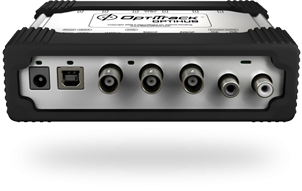Produktbeschreibung
Improve power regulation, camera syncing, tracking distance and interoperability. Features include external sync in/out, shutter glasses support, and more. Each 6-port OptiHub 2 comes with removable mounting tabs and a universal power supply (US/EU-compatible)
In the Box
- 1 OptiHub 2
- 2 Mounting tabs (removable)
- 1 12V universal power supply
(US/EU-compatible) - 1 European power cable
- 4 Rubber feet
- 1 OptiHub quick start guide
- 10 Velcro straps

On-board voltage regulation
On-board voltage regulation provides stable, consistent power distribution to cameras, unlike COTS hubs which varies the voltage based on the power load to the hub. Reliable power to every camera maximizes IR strobe brightness, resulting in more consistent tracking and fewer dropped markers.

Shutter glasses support
Both NuVision and RealD shutter glasses are now supported for integration into OptiTrack environments. External syncing allows the camera strobe and shutter glass sequencing to be staggered, reducing interference between the two. Learn more

External sync in/out
Integrate OptiTrack into large scale tracking and analytical ecosystems with external sync in and out. Utilize frame triggers or free-run triggering to synchronize frame cycling with external software controls and hardware components like force plates and shutter glasses.

Hub-to-hub syncing
OptiHubs in the same chain automatically propagate sync data to all connected cameras. OptiSync provides connection topology data for cameras and hubs in relation to each other, enabling automatic camera numbering based on port location.
What is the difference between Wired Sync and OptiSync? Learn more

Sync signal over USB
With OptiSync, NaturalPoint's custom synchronization system, sync signals are sent and received over the USB cable. As a result, cabling is reduced by 50%, which enables simpler setup and cleaner rigs.

High power mode
High Power Mode is available for the Flex 13 and the Flex 3, which are specifically designed for use with the OptiHub. It allows cameras to draw additional power for the strobe, which increases effective capture range, allows for wider FOV lenses and smaller markers to be used.

USB uplink with status LEDs
Meaningful status LEDs enable monitoring of each port's activity, including whether the port is operating in high speed or full speed mode.



